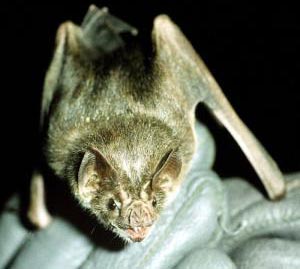The bat's breath reveals the uniformity of the latest victim of the Devil's Bat
Danh Phuong
Devil bats living in Latin America have turned to animal blood meals instead of rainforest mammals , many ecological physiologists from the Wildlife Research Institute And Leibniz Zoo, Berlin, the Freie Universität Berlin, the Humboldt Universität zu Berlin report together in Comparative Physiology B of Aberdeen University.
They say the transformation of tropical forest ecosystems into farmland for livestock production has led to the expansion of demonic bat populations in Latin America.
Farmers are watching demon bats satisfy their blood needs by attacking cattle instead of wild mammals. To document this change of activity, Professor Christian Voigt and his colleagues analyzed the ratio of sustainable carbon isotopes of CO 2 emitted by demon bats.

Devil Bats (Photo provided by Wildlife Research Institute and Leibnez Zoo and Garden)
They gave the blood-locked, demonic bats of a kind of stable (non-radioactive) carbon 13 and then tracked the time between blood meal and the presence of fixed carbon atoms. emanating from the breath. Dr. Voigt said: ' Devil bats have eaten fresh blood very quickly to fuel their metabolism; less than 1 hour later, the sign of sustainable carbon isotopes emanating from the demon bat's breath is similar to the most recent regular menu. '
The researchers collected the breaths of demonic bats that were bred in Costa Rica's natural conditions and analyzed for its sustainable carbon isotope signature. Dr. Voigt went on to say: 'Potential victims: are either cattle or mammals in tropical forests such as tapirs and porcupines. These two animal groups are fed with separate plants with isotopes like grass for the case of cattle and herbs or shrubs for tropical mammals. Therefore, we hope that the stable carbon isotope sign in bat's breath can vary according to their daily menu. The demon bat's breath clearly tells us that their last blood meal is almost always of animal origin, despite the presence of tropical mammals . "
The authors argue that demon bats do not necessarily like animal blood, but for demon bats, cattle are much easier to find than tropical mammals. Cattle are grazed on the fenced outdoor meadows, but on the contrary, the mammals roam here and there in the dense vegetation. The transformation of tropical forests into cattle pastures has a huge impact on mammals in the native Latin America region, which is generally not useful for the original mammal.
Devil bats live only in Central and South America and weigh between 30-40 g. Devil bats divide food for members of the group who are not with them, an action known as altruism to one another, but this altruistic altruism is also found in the demon bat as it is in humans.
Note: This article is based on a fact sheet published by the Wildlife Research Institute and the Leibnez Zoo.
- How do bats spread disease globally?
- 8 ways against the culprit causing bad breath
- Ebola outbreaks stem from boys playing near bats
- Into the forest, catch bats
- It was possible to test 8 types of cancer and 9 other diseases with just one breath
- Discover new bats on dogs in Panama and Ecuador
- Terrible hot sun causes bats to fall like a fig in Australia
- The truth shudders about Satan devils
- Discover panda bat in South Sudan
- Japan develops robot to detect bad breath, foot odor
- Discover 4 strange bat species
- New discoveries about bats: Male bats use food to propose
 Animal 'suffering' after hibernation
Animal 'suffering' after hibernation Why do goats climb well?
Why do goats climb well? Scientists were surprised to see chimpanzees eating turtles
Scientists were surprised to see chimpanzees eating turtles Giant catfish died deadly due to drought in Thailand
Giant catfish died deadly due to drought in Thailand